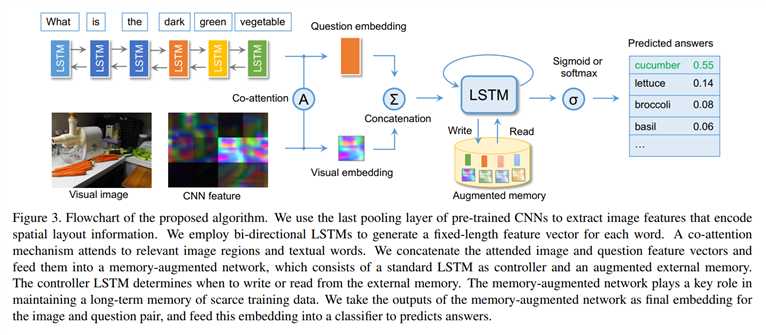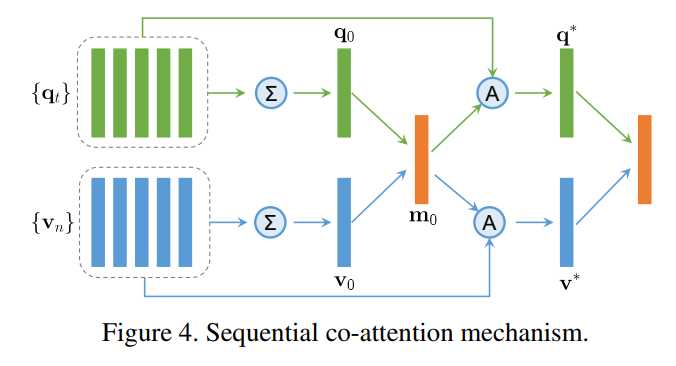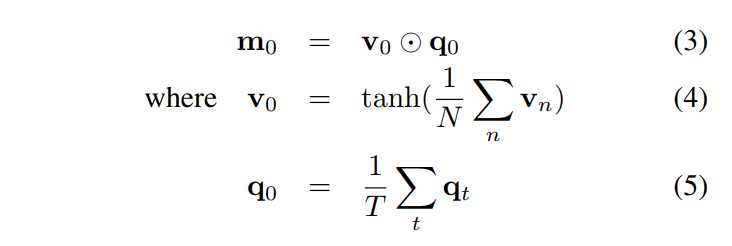标签:term nat 状态 for tput obj sof element hot
Visual Question Answering with Memory-Augmented Networks
2018-05-15 20:15:03
Motivation:
虽然 VQA 已经取得了很大的进步,但是这种方法依然对完全 general,freeform VQA 表现很差,作者认为是因为如下两点:
1. deep models trained with gradient based methods learn to respond to the majority of training data rather than specific scarce exemplars ;
用梯度下降的方法训练得到的深度模型,对主要的训练数据有较好的相应,但是对特定的稀疏样本却不是;
2. existing VQA systems learn about the properties of objects from question-answer pairs, sometimes indepently of the image.
选择性的关注图像中的某些区域是很重要的策略。
我们从最近的 memory-augmented neural networks 以及 co-attention mechanism 得到启发,本文中,我们利用 memory-networks 来记忆 rare events,然后用 memory-augmented networks with attention to rare answers for VQA.

The Proposed Algorithm :
本文的算法流程如上图所示,首先利用 embedding 的方法,提取问题和图像的 feature,然后进行 co-attention 的学习,然后将两个加权后的feature进行组合,然后输入到 memory network 中,最终进行答案的选择。
Image Embedding:用 pre-trained model 进行特征的提取;
Question Embedding:用双向 LSTM 网络进行语言特征的学习;
Sequential Co-attention:

这里的协同 attention 机制,考虑到图像和文本共同的特征,相互影响,得到共同的注意力机制。我们根据 视觉特征和语言特征的平均值,进行点乘,得到一个 base vector m0 :

我们用一个两层的神经网络进行 soft attention 的计算。对于 visual attention,the soft attention 以及 加权后的视觉特征向量分别为:

其中 Wv, Wm,Wh 都表示 hidden states。类似的,我们计算加权后的问题特征向量,如下:

我们将加权后的 v 和 q 组合,用来表示输入图像和问题对,图4,展示了 co-attention 机制的整个过程。
Memory Augmented Network:
The RNNs lack external memory to maintain a long-term memory for scarce training data. This paper use a memory-augmented NN for VQA.
特别的,我们采用了标准的 LSTM 模型作为 controller,起作用是 receives input data,然后跟外部记忆模块进行交互。外部记忆,Mt,是有一系列的 row vectors 作为 memory slots。
xt 代表的是视觉特征和文本特征的组合;yt 是对应的编码的问题答案(one-hot encoded answer vector)。然后将该 xt 输入到 LSTM controller,如:

对于从外部记忆单元中读取,我们将 the hidden state ht 作为 Mt 的 query。首先,我们计算 搜索向量 ht 和 记忆中每一行的余弦距离:

然后,我们通过 the cosine distance 用 softmax 计算一个 read weight vector wr:
![]()
有这些 read-weights, 一个新的检索的记忆 rt 可以通过下面的式子得到:

最后,我们将 the new memory vector rt 和 controller hidden state ht 组合,然后产生 the output vector ot for learning classifier.
我们采用 the usage weights wu 来控制写入到 memory。我们通过衰减之前的 state 来更新 the usage weights :
![]()
为了计算 the write weights,我们引入一个截断机制 来更新 the least-used positions。此处,我们采用 m(v, n) 来表示 the n-th smallest element of a vector v. 我们采用 a learnable sigmoid gate parameter 来计算之前的 read weights 和 usage weights 的 convex combination:

A larger n results in maintaining a longer term of memory of scarce training data. 跟 LSTM 内部的记忆单元相比,这里的两个参数都可以用来调整 the rate of writing to exernal memory. 这给我们更多的自由来调整模型的更新。公式(12)中输出的隐层状态 ht 可以根据 the write weights 写入到 memory 中:

Answer Reasoning:
有了 the hidden state ht 以及 那个外部记忆单元中得到的 the reading memory rt,我们将这两个组合起来,作为当前问题和图片的表达,输入到分类网络中,然后得到答案的分布。

--- Done !
Visual Question Answering with Memory-Augmented Networks
标签:term nat 状态 for tput obj sof element hot
原文地址:https://www.cnblogs.com/wangxiaocvpr/p/9042996.html